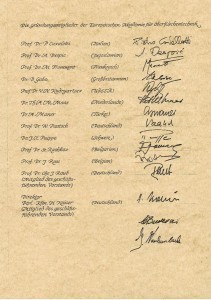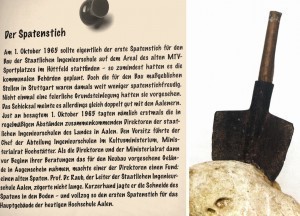The Zentrum für Oberflächentechnik Schwäbisch Gmünd e.V. (Z.O.G.), founded on 28.11.1986, is an association of schools, institutions and companies that offer events for training and further education in the field of surface technology.
The work of the Z.O.G. has attracted great interest and attention both nationally and internationally. For this reason, just two years later, in October 1988, at the suggestion of Professor Dr. Seifriz, a former minister of Schwäbisch Gmünd, and with the decisive assistance of the Lord Mayor of Schwäbisch Gmünd, Dr. W. Schuster, Dr. H. Ohnewald, a member of the state parliament, other state politicians, industry representatives and scientists, a European Committee for Surface Technology was founded.
This committee was made up of leading representatives from industry and science who were active in the field of surface technology. The board of this committee consisted of the Lord Mayor of the city, Dr. W. Schuster, and his two deputies Professor Dr. Ch. J. Raub (Research Institute for Precious Metals and Metal Chemistry, Schwäbisch Gmünd) and Director H. Kaiser (Degussa Schwäbisch Gmünd). This committee was the cornerstone for the consistent expansion of international activities and founded the European Academy of Surface Technology (EAST) on October 15, 1989 in Schwäbisch Gmünd in the presence of many prominent figures from international business, science and politics.
The initiators and organizers of the founding of the EAST as well as founding members were Director Hasso Kaiser (Degussa Schwäbisch Gmünd) and Prof. Christoph Raub (Research Institute for Precious Metals and Metal Chemistry, Schwäbisch Gmünd).
 Fig. 4: 30th anniversary of EAST
Fig. 4: 30th anniversary of EAST
The other founding members included:
- Professor Dr. P. Cavallotti (Technical University of Milan/Italy)
- Professor Dr. A. Despic (University of Belgrade/Yugoslavia)
- Professor Dr. M. Froment (Institute Physique des Liquides et Electrochimie, Paris/France)
- Dr. D. Gabe (University of Loughborough, England)
- Professor Dr. V. N. Kudryavtsev (Mendeleev University of Chemical Engineering, Moscow/USSR)
- Dr. Th. A M. Maas (Philips, Eindhoven/Netherlands)
- Dr. A. Maner (Elfo AG, Sachseln/Switzerland)
- Prof. Dr. W. Paatsch (BAM, Berlin/Germany)
- Dr. J. C. Puippe (W. Flühmann AG, Zurich/Switzerland)
- Professor Dr. St. Rashkov (Bulgarian Academy of Sciences, Sofia/Bulgaria)
- Professor Dr. J. Roos (University of Leuven/Belgium).
 Fig. 5: Founding document of the European Academy of Surface Technology (EAST)The new members elected during the meeting were Dr. J. Vanhumbeek (Siemens AG, Oostkamp/Belgium) and Professor Dr. E. Budevski (Bulgarian Academy of Sciences, Sofia/Bulgaria).
Fig. 5: Founding document of the European Academy of Surface Technology (EAST)The new members elected during the meeting were Dr. J. Vanhumbeek (Siemens AG, Oostkamp/Belgium) and Professor Dr. E. Budevski (Bulgarian Academy of Sciences, Sofia/Bulgaria).
The President of the American Electroplaters and Surface Finishers Society, St. Schachamayer and the Managing Director H. Schumacher as well as the Vice President of the Surface Finishing Society of Australia, B. Wilson, were present as associate members.
The patronage was assumed by the Vice-President of the European Parliament, S. Alber, P. M. Schmidhuber from the European Community, Dr. H. Riesenhuber, Minister for Research and Technology, Bonn (represented by Dr. D. Widdershoven), H. Schaufler, Minister for Economics, Small and Medium-Sized Enterprises and Technology Baden-Württemberg, Stuttgart, and Dr. W. Schuster, Lord Mayor of the City of Schwäbisch Gmünd.
On October 14, 1989, the founding members of the Academy discussed and defined the goals and focal points of its work in a working session.
EAST's statutes describe its tasks as follows:
- To intensify cooperation within Europe in the field of electroplating and surface technology.
- To intensify technology transfer between science and industry in the field of surface technology by organizing further education and training events.
- To form a forum for European science and technology transfer as an information center.
- To promote the development of environmentally friendly processes and products through European cooperation.
- To recognize outstanding European contributions to technology transfer by awarding the "European Prize for Surface Technology".
- To work in partnership with national and international institutions of education and science as well as industry.
It was expressly stipulated that the Academy should contribute to European cooperation between science and industry, mutual understanding between East and West and worldwide friendship.
In addition to European scientific institutions such as universities, colleges and research institutes, which are actively involved in EAST, great importance was attached to cooperation with European industry.
In October 2019, EAST celebrated its 30th anniversary and can look back on an extraordinarily successful development. The annual meetings of EAST members were and are always a good opportunity for new ideas and joint projects within the framework of European research programs.
In addition to numerous research activities by various consortia of EAST members, the focus has always been on the further training of young scientists in the field of electrochemistry and electroplating and surface technology. Through the activities of EAST, Schwäbisch Gmünd has succeeded in establishing itself internationally as a center in these fields of technology. This is also demonstrated by the fact that the conferences were held in Athens, Barcelona, Milan and Schwäbisch Gmünd as part of an international further education project (MINDE). This also created the opportunity to continuously integrate young scientists into the EAST network and thus secure its future.
The electroplating activities in the Schwäbisch Gmünd area are also closely linked to the beginnings of Aalen University of Applied Sciences (HTW). The first director of the Aalen School of Engineering, which was founded on October 1, 1962, was Professor Ernst Raub, who had already successfully headed up the precious metals testing and research institute - today's Research Institute for Precious Metals and Metal Chemistry (fem) - since 1934 [7]. The engineering department for metal refinement and materials science in Schwäbisch Gmünd, which had existed since 1957, was affiliated to the Aalen School of Engineering on January 1, 1963, but remained in Schwäbisch Gmünd until March 1969.
The founding of the HTW Aalen was preceded by almost 10 years of struggle between two key figures: Lord Mayor Dr. Karl Schübel and District Administrator and State Minister Dr. Anton Huber were vehemently committed to the Aalen location. All levels of local and state politics were involved and the many patient and sometimes tough negotiations ultimately led to a decision in favor of the Aalen site.
 Fig. 6: The "history" of the ground-breaking ceremony and the original spade (8)From its modest beginnings with 32 students, one of the most research-intensive universities of applied sciences in Baden-Württemberg has emerged in just under six decades. Around 5800 students take advantage of over 50 Bachelor's and Master's degree programs from five faculties. HTW Aalen is a reliable partner in the "region of talents and patents" for the regional economy, associations and more than 100 cooperation partners worldwide. When Aalen University began operations in 1963, around five to six percent of each year group studied at the university. Today, the figure in Germany is 54 percent [9].
Fig. 6: The "history" of the ground-breaking ceremony and the original spade (8)From its modest beginnings with 32 students, one of the most research-intensive universities of applied sciences in Baden-Württemberg has emerged in just under six decades. Around 5800 students take advantage of over 50 Bachelor's and Master's degree programs from five faculties. HTW Aalen is a reliable partner in the "region of talents and patents" for the regional economy, associations and more than 100 cooperation partners worldwide. When Aalen University began operations in 1963, around five to six percent of each year group studied at the university. Today, the figure in Germany is 54 percent [9].
The Ostwürttemberg region can boast a wide range of activities in the field of surface technology and was honored as a winner of the regional cluster competition Baden- Württemberg.
Although the industry is small in terms of the number of employees, strong international impetus comes from the region. This is due in particular to the development of training opportunities in the field of surface technology in this region and the close networking of the players. Industrial training as a surface coater with school support from the oldest vocational school in Baden-Württemberg [10] ensures a solid basis for a successful career. Successful completion of the surface coater course opens the door to training as a technician or master craftsman in Schwäbisch Gmünd in order to be able to take on specialist or management responsibility.
The insight into the international world of surface technology motivates many graduates of industrial training to go on to study materials science and surface technology, for example at the HTW Aalen. Here, interested and cosmopolitan students can quickly establish contacts with well-known companies or university institutions and build up a valuable network. The motto "Be smart, do V" has applied among Aalen students for generations. Electroplating specialists from the region can be found in all parts of the world and in many branches of industry. Due to the solid and consistent training opportunities with high practical relevance, they are sought-after and qualified applicants in the industry.
The Research Institute for Precious Metals and Metal Chemistry (fem) plays another important role in the perception of Gmünd's electroplating activities in the world. Since its foundation in 1922, thousands of technical and scientific publications have been written. These form a solid scientific basis, particularly in the field of precious metal electroplating. The highly qualified and experienced employees are sought-after speakers at international conferences and are involved in many project and technical committees.
Looking at the manageable number of experts in the field of electroplating in the world, one quickly realizes that the East Wuerttemberg region makes a contribution that goes far beyond national borders.
The key to this remarkable development lies in the holistic orientation of the training opportunities in the region and the joint commitment of politics, science and industry.
-Hasso Kaiser, Dr. Andreas Zielonka, Thomas Engert-
Sources:
[6] Images from EAST
[7] 80 years of fem, Research Institute for Precious Metals and Metal Chemistry
[8] 50 years of Aalen University, Chapter: Held fast
[9] https://www.hs-aalen.de/pages/ueber-uns
[10] https://www.gs-gd.de/Geschichte.html

![History[s] of electroplating - Training in the Schwäbisch Gmünd area (Part 2)](/images/k2/6ec8f23a185390c71ebf079585a50f75.jpg)
